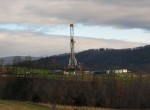Author: Kim Martineau8
-

Watch an Antarctic Iceberg in the Making
What does a glacier about to spawn an iceberg the size of New York City look like? A new animation from NASA flies you through the 19-mile crack that is slowly tearing Antarctica’s Pine Island Glacier apart.
-

Ohio Quakes Probably Triggered by Disposal Well, Say Seismologists
Earthquakes that have shaken an area just outside Youngstown, Ohio, in the last nine months are likely linked to a disposal well for injecting wastewater used in the hydraulic fracturing process, say LDEO seismologists.
-

Ancient Dry Spells, Future Risk?
The last major drought to hit the northeastern U.S. lasted three years and shrunk New York City’s reservoirs by nearly three quarters. But as bad as that drought was, the region has seen at least three dry spells in the last 6,000 years that were far worse, says Dorothy Peteet, a climate scientist at Columbia…
-

Scientific Publisher to Provide Easy Access to Study Data
Modern society is awash in data. By one estimate, as much information today is created in 48 hours as was produced in the last 30,000 years. The challenge now is making all those megabytes public. This month, Elsevier, publisher of The Lancet and Cell, announced that it would establish reciprocal linking between its geochemistry journals…
-

Imagining the Hudson before Humans
Pollution is just one way that humans have transformed the Hudson River. A small way, it turns out. We have altered the Hudson’s shape, the speed of its flow and the mix of plants and trees along its banks. In a new book, Environmental History of the Hudson River, two Lamont-Doherty scientists who contributed chapters—Frank…
-

Climate Scientist Studies Ancient Shorelines
The seas are rising, as they have during past periods of warming in earth’s history. Estimates of how high they will go in the next few thousand years range from five meters, putting greater Miami underwater, to 40 meters, wiping most of Florida off the map. “The range of estimates is huge to the point…
-

Drilling for Carbon-Storing Rocks in Suburban New York
Under the shopping malls and highways of suburbia, there might one day be a partial fix for global warming. Since August, engineers have been drilling just west of the Tappan Zee Bridge to collect samples of rock from the Newark Basin, an ancient rock formation stretching beneath New York, New Jersey and Pennsylvania. As they…
-

Magnitude 5.8 Quake Rattles East Coast
The magnitude 5.8 earthquake that shook central Virginia on Tuesday afternoon is one of the biggest earthquakes to hit the East Coast since 1897, and was comparable in strength to a quake on the New York-Canadian border in 1944, according to the U.S. Geological Survey. It was centered near Mineral, Va., about 38 miles northwest…
-

Atmospheric Scientists Win Early Career Awards
Two scientists at Lamont-Doherty Earth Observatory have been recognized for early-career achievement in the atmospheric sciences by the American Geophysical Union (AGU), the world’s largest earth-sciences organization. Tiffany Shaw, 31, is a physicist who uses computer models and mathematical equations to study the basic dynamics of the atmosphere and climate, for instance, how the jet…
